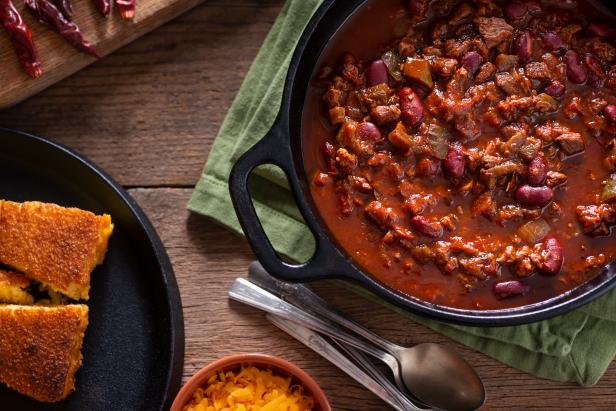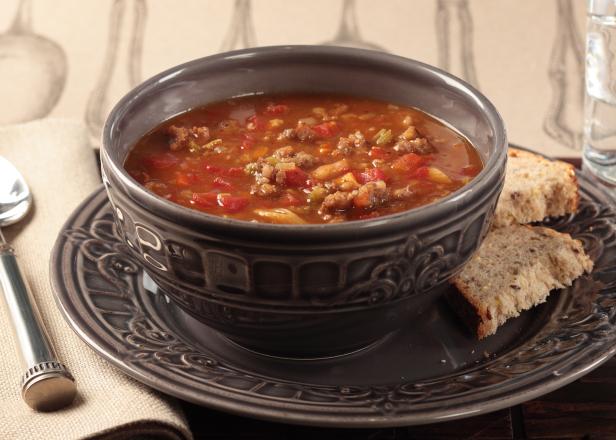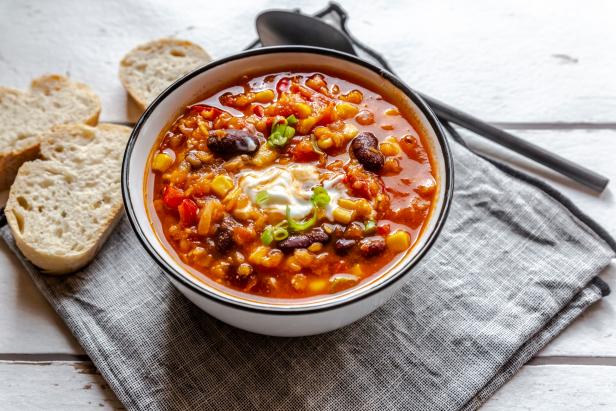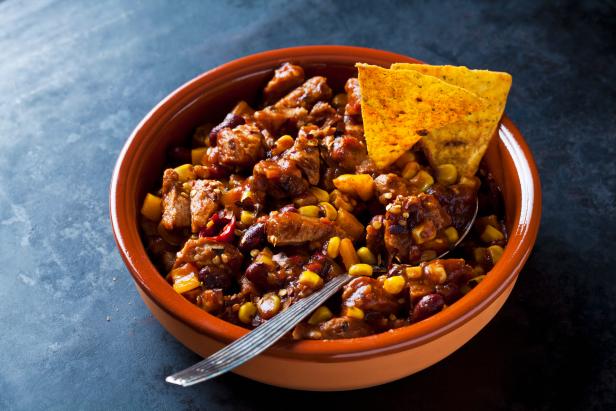Chili is a classic dish beloved for its robust flavor and thick texture, whether it’s made with beef, beans or chicken, or enjoyed by the bowlful or on top of hot dogs. So, when your pot of chili is watery and lackluster, it can be pretty disappointing. But why does this happen, and how can it be remedied? For more info and intel on ways to thicken chili, we consulted Seth Gross, owner of Bull City Burger and Brewery and Bull City Solera and Taproom in Durham, NC.
Steve Lalich/Getty Images
Much like soups and stews, chili can be thin for a variety of reasons including high water content, using certain ingredients such as fresh tomatoes or frozen vegetables and not reducing it for enough time.
Too much liquid: A major reason your chili is thin is that you might be adding too much beer, wine, stock or other liquid at the start.
Fresh Tomatoes: If you’re using fresh tomatoes rather than canned, note that they have a higher water content and can result in your chili having a thinner consistency.
Frozen Vegetables: If you’re adding frozen vegetables, such as corn, it will add extra moisture to the chili. Gross recommends thawing and draining frozen vegetables before adding them to the chili.
Short Cook Time: Not reducing your chili enough means there isn’t adequate time for evaporation to occur and thicken the chili. “Reducing the moisture level is important for both thickening, but also concentrating flavor,” Gross says.
About this method: Simmering your chili with the lid off helps to evaporate moisture, thereby reducing the water content. It also helps to concentrate flavor.
When to use: If you add too much liquid at the start, if you’re using fresh tomatoes or if the chili is too brothy.
- If you add too much water or stock at the start: “Take your time slowly simmering the meat to drive the moisture off before you add in anything else,” Gross advises. “It’s important to get that moisture gone before you add any of your spices such as chili powder. You don’t want to make the chili out of balance by adding too much spice while the chili is watery.”
- If you’re using fresh tomatoes: “I would suggest either reducing the chili on low heat to drive that moisture out or to cook the tomatoes separately to thicken them before adding to the chili,” Gross says. Simply puree the tomatoes, add to a pot and simmer on low heat, stirring frequently until they become a thick tomato reduction. “You do have to be careful doing this because as you reduce moisture the chance of scorching becomes much more possible,” Gross says. “Be sure to keep the lid off so the moisture can escape.”
- If the chili is generally too brothy: Set heat to low and allow the chili to simmer until enough liquid has evaporated and the chili has reached the desired consistency.
About this method: The starch in mashed beans or refried beans will help to thicken the chili without diluting flavor, though a good rule of thumb is to taste to determine if extra seasoning is needed.
When to use: For bean- and meat-and-bean based chilis.
What to do: Stir in 1 cup of pre-mashed beans or refried beans to the chili and heat through. Gross offers a word of caution when it comes to adding beans to chili: “Your beans have to be completely pre-cooked, and partially mashed or fully mashed,” he says. “Beans will not cook in a chili if there is any acid, i.e. tomato, for example.”
About this method: Adding corn chips, such as crushed tortilla chips or Fritos, will help soak up liquid as they soften. This helps to thicken the chili and add flavor without being overpowering.
When to use: Any time your chili is watery or thin.
What to do: “One of the great culinary dishes is the individual Frito bag with a scoop of chili, eating it with a fork right out of the bag,” Gross says. “You can do this with your pot of chili by adding corn chips and stirring them in to absorb moisture.” Gross suggests adding roughly 1 cup of chips per quart of loose chili.
Method 4: Add Blended Tortillas
About this method: Adding blended corn tortillas not only absorbs extra moisture, but it also adds texture and flavor.
When to use: Any type of chili that is thin.
What to do: Use a 1-cup measuring cup to scoop out liquid from the pot of chili. If necessary, tip the pot sideways to run the liquid to the edge and scoop. Add one six inch tortilla, torn to pieces, per cup of liquid to a blender and puree. Then add the pureed tortilla back to the pot and simmer on low heat to allow it to thicken, stirring frequently. Cook for about 10 minutes to allow the tortilla to hydrate.
About this method: Adding medium diced potatoes or another starchy vegetable will help thicken the chili by releasing starch as they cook and adding body.
When to use: For watery chili.
- If the chili is extra, extra watery: Add 1 to 2 medium peeled, diced potatoes to the pot and allow them cook in the chili. “Your chili has to be pretty watery for this one to work,” Gross says. “If it’s just a little bit thin you might have to add some stock or water to your chili so the potatoes can keep cooking.”
- If the chili is slightly less watery: Remove 2 cups of chili liquid and cook 1 medium peeled, diced potato in the liquid until soft, then purée and add back to the main batch of chili.
Can You Use a Slurry to Thicken Chili?
“I would not recommend a starch or cornstarch slurry for thickening a chili,” Gross says. “This could backfire and make it a bit slimy in texture.”







